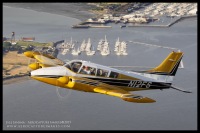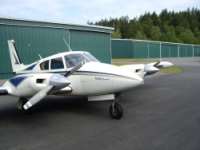What is the service ceiling for a factory twin turbo Comanche?
I'm told cruise speeds of 180-190 kts are realistic for the turbo in the mid-teens. Does that sound about right?
Has anyone seen de-ice boots on a twin Comanche? Does the system work the same as larger piston aircraft with boots?
Thanks.
Turbo Twinkie Specs
11 posts
• Page 1 of 1
If I recall correctly, the ceiling of a turbo PA 30 is 30,000 feet. While I know owners who've been to FL 250 I personally think that FL 200 is about the practical limit. I've been that high several times and the airplane does just fine, although it is maybe just a teeny bit mushy compared to even FL 180.
For practical purposes, if the weather is bad enough that I can't get on top by 20,000 feet, then it's probably bad enough that I don't need to be flying around in a Comanche. IMHO.
Where the turbos really shine is in the mid teens. At that level the plane flies great and nasal cannulas (cannuli?, approved for use up to 18,000 feet) are reasonably comfortable. 180 KTS TAS at those altitudes is easily achievable. Assuming the turbo system is in good shape and you run a little harder you can get close to 200 KTS TAS.
There are booted Twin Comanches around, but I'll let someone who owns one comment on them.
Best,
Jay
For practical purposes, if the weather is bad enough that I can't get on top by 20,000 feet, then it's probably bad enough that I don't need to be flying around in a Comanche. IMHO.
Where the turbos really shine is in the mid teens. At that level the plane flies great and nasal cannulas (cannuli?, approved for use up to 18,000 feet) are reasonably comfortable. 180 KTS TAS at those altitudes is easily achievable. Assuming the turbo system is in good shape and you run a little harder you can get close to 200 KTS TAS.
There are booted Twin Comanches around, but I'll let someone who owns one comment on them.
Best,
Jay
Jay
PA 30 N7702Y
PA 30 N7702Y
-

Jay - ICS member

- Posts: 473
- Joined: Tue Sep 30, 2003 10:59 pm
- Location: Portland, Oregon
Turbo Twinkie Specs
Jay, All,
I'm new to the TwinCo, but surprised this question would come up.
That's cause I've been stuydying the Doug Killough Turbo Twin handbook recently and it says the absolute ceiling is 25,000 feet.
Is the service ceiling different than the absolute ceiling?
OK, read it again and it gives both ceilings at 25,000- Multi-Engine.
But 8,800 for Service, and 12,600 for Absoulute - on one engine.
All at gross wt of 3,725 lbs.
BTW, I have a couple early/draft/sample copies of that handbook, available for $40 payable to ICS - if anyone is interested.
Don
I'm new to the TwinCo, but surprised this question would come up.
That's cause I've been stuydying the Doug Killough Turbo Twin handbook recently and it says the absolute ceiling is 25,000 feet.
Is the service ceiling different than the absolute ceiling?
OK, read it again and it gives both ceilings at 25,000- Multi-Engine.
But 8,800 for Service, and 12,600 for Absoulute - on one engine.
All at gross wt of 3,725 lbs.
BTW, I have a couple early/draft/sample copies of that handbook, available for $40 payable to ICS - if anyone is interested.
Don
-

Don Nelson - ICS member

- Posts: 312
- Joined: Mon Nov 10, 2003 5:57 pm
- Location: Burlington, Washington; KBVS
Please PM the address you wish the check to be sent to. Those manuals are wonderful. I have one for my PA-28-180 and it is full of great information.
BTW, I am looking for a CFI in the Seattle area with at least 25 Twinco hours for insurance required check out if you know anyone.
BTW, I am looking for a CFI in the Seattle area with at least 25 Twinco hours for insurance required check out if you know anyone.
-

T210DRVR - ICS member

- Posts: 117
- Joined: Sat May 03, 2008 4:31 am
- Location: So. Oregon
From the Piper Turbo Twin Comanche B – Owners Handbook
Absolute Ceiling - 25,000
Service Ceiling - 25,000
Single Engine Absolute Ceiling - 12,600
Single engine Service Ceiling – 8,800
Top Speed at 20,000 – 240 mph
Absolute Ceiling - 25,000
Service Ceiling - 25,000
Single Engine Absolute Ceiling - 12,600
Single engine Service Ceiling – 8,800
Top Speed at 20,000 – 240 mph
-

Charlie Tripp - ICS member

- Posts: 382
- Joined: Thu Jun 27, 2002 5:38 pm
- Location: Brownsville, TN
"Absolute Ceiling - 25,000
Service Ceiling - 25,000 "
IIRC, the 25,000' ceiling is an FAA requirement - an unpressurised A/C is restricted to 25,000' while performance-wise, a turbo twinky in good shape will make it to 30,000'
the fact that the stated absolute and the service ceilings are identical (see above quote) would seem to support that - normally the absolute ceiling, if performance based will be higher than the service ceiling.
françois
Service Ceiling - 25,000 "
IIRC, the 25,000' ceiling is an FAA requirement - an unpressurised A/C is restricted to 25,000' while performance-wise, a turbo twinky in good shape will make it to 30,000'
the fact that the stated absolute and the service ceilings are identical (see above quote) would seem to support that - normally the absolute ceiling, if performance based will be higher than the service ceiling.
françois
- CLIPCLIP
- ICS member

- Posts: 97
- Joined: Thu Dec 23, 1999 2:06 am
- Location: Montreal, Quebec, Canada
I can confirm that the original aircraft was certified to 30K, and the old performance charts show this, however the requirement for either secondary supplimental O2 as well as standards and testing for emergency descent to non O2 altitudes were subsequantly instituted. They were not required for aircraft limited to FL250 and below. Rather than recertify the turbo PA-30, the FL 250 limitation was applied to the type, and the rest as they say, is history.
-Zach
-Zach
"Keep it above 5 feet and don't do nuthin dumb!"
-

Zach Grant L1011jock - Technical Advisor
- Posts: 1404
- Joined: Mon Mar 22, 2004 4:35 pm
- Location: Indianapolis KEYE
11 posts
• Page 1 of 1
Return to Maintenance - General
Who is online
Users browsing this forum: No registered users and 68 guests
